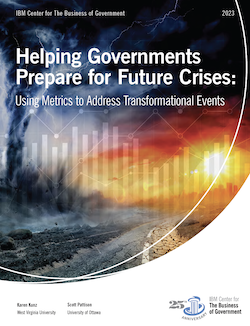
Helping Governments Prepare for Future Crises

This new report analyzes how a shock to the system of this magnitude has impacted governments’ ability to use emergency dollars for public services, and draws on this analysis to develop recommendations for how states can use future recovery funds to help deliver key services during critical times of need. The report brings a broad-scoped analysis together with examination of three state-based cases, to explore how the alignment and effectiveness of funded activities are measured, and to identify lessons to guide states in deploying resources to address future transformational events.
The authors’ work complements our Center’s ongoing initiative to develop research to help governments in preparing for and responding to “future shocks”—systemic crises including health events as well as cyber incidents, climate changes, supply chain disruptions, and workforce shortages. The future shocks initiative includes numerous reports and related publications, issued in collaboration with the National Academy of Public Administration, IBM Institute for Business Value, and other partners.
This report also continues the Center’s longstanding research and recommendations around using performance information to improve government operations.
We hope that state and federal leaders and stakeholders find this report helpful in developing strategies to address increasingly common transformational crises.



